The biometric driver identification system market is expected to reach USD 21,457 Million in 2025 and USD 184,410 Million by 2035, growing at a CAGR of 24% during the forecast period. The growing demand for vehicle safety, increasing adoption of connected and autonomous vehicles, biometric technologies, and vehicle security and identity management solutions is driving the growth of the market.
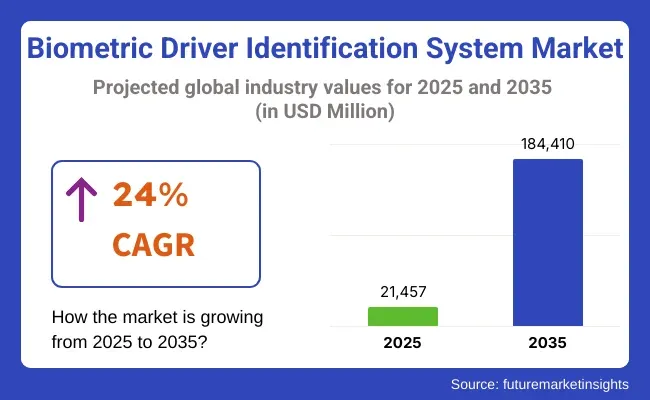
On account of the growing adoption of advanced security and personalization in vehicles, the biometric driver identification system market is set to grow phenomenally between 2025 and 2035. Using biometric systems based on fingerprint recognition, facial recognition, and biometric iris scanning, vehicle security is improved by only letting authorized individuals drive the vehicle. They also provide individualized experiences by modifying vehicle settings to match the driver's preferences.
The global biometric driver identification system market is witnessing immense growth due to the need for better vehicle security, driver-specific customization, and an aim to prevent theft. From improved authentication and access control to personalized user experiences, like automatic seat positioning, infotainment preferences, and climate control, more and more automakers are building biometric systems into their vehicles.
Regarding the types of vehicles, Passenger Cars hold the largest market share, while Fingerprint Recognition becomes the most widely used identification technique, due to its accuracy, speed, and ease of integration.
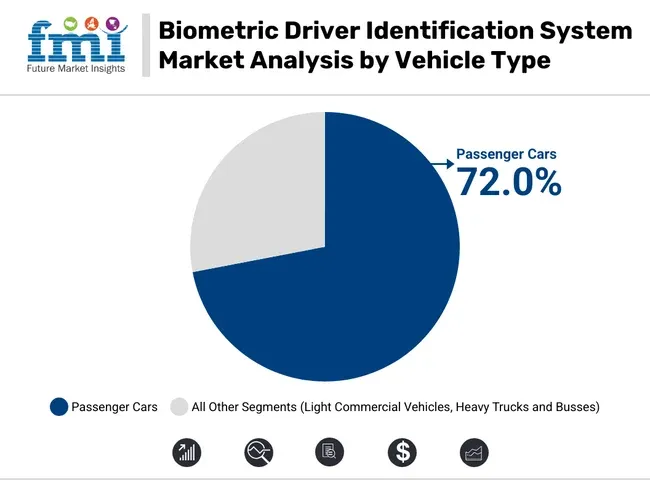
Passenger Cars Dominate as OEMs Prioritize Driver-Centric and Safety-Focused Technologies
Passenger-type cars, including compact, mid-size, and premium types, account for more than 70% of the biometric driver identification market. The increasing emphasis on in-vehicle customization, theft deterrence, and driver-specific insurance quotes is driving the rollout of biometric systems in this market segment.
High-end and premium vehicle manufacturers lead the way with advanced driver rehabilitation and access control solutions, incorporating multimodal biometric systems (utilizing fingerprint, iris and facial recognition). Biometrics for next-gen automotive ecosystems is also being facilitated by the growing adoption of connected car platforms and IoT-based telematics.
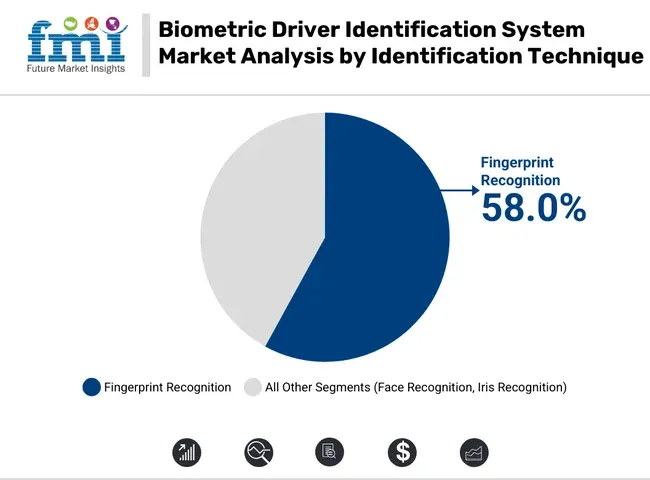
Fingerprint Recognition Leads Due to Ease of Use, Reliability, and Cost Efficiency
Fingerprint recognition is a prevalent technique; it is already being employed in various consumer electronics devices, and is cheaper and faster than most other techniques. It is extensively utilized for driver identification, access control, and ignition authorization.
Fingerprint systems, which tend to be less intrusive and easier to incorporate into steering wheels or dashboard interfaces, and are highly accurate under multiple lighting environments, are the preferred biometric solutions among automakers. At the same time, facial and iris detection solutions are being adopted in luxury and autonomous vehicles, where contactless interaction and real-time monitoring are much more necessary.
Challenge
High Implementation Costs and Privacy Concerns
A big problem for the biometric driver identification system market is the high cost of putting these systems in cars. These include face recognition cameras, fingerprint readers, and eye scanners. They need a lot of money for hardware, setup, and tests. This, in turn, raises the car's total cost, making it less attractive, especially in poorer areas where buyers focus on price.
Moreover, worries about data privacy and security stop many people from embracing it. Biometric systems gather and keep private information, posing a high risk of data leaks and wrongful use if security is not strong. People are wary of how their data is handled. Lack of clear rules and open data practices might slow down market growth despite these systems' advantages.
Opportunity
Advancements in Autonomous Vehicles and Connected Car Technologies
The rise of self-driving cars and smart car tech is opening big opportunities for the Biometric Driver ID market to grow. As cars get smarter and more linked to bigger digital networks, safe and easy driver interactions become very important. Biometric tech is great for this, offering real-time checks, customized driver profiles, and better safety like sleepiness checks and behavior monitoring.
In self-driving cars, where drivers sometimes don't need to do much, biometric tech can make sure only approved people can drive, cutting down on risk and keeping riders safe. Also, smart cars use cloud-based biometric tech to share data across systems, making the user experience better. Big car and tech firms are spending a lot on research to make this tech cheaper, smaller, and easier to scale, which should help it spread to cheaper cars, too. As this tech gets better, biometrics will likely become a common feature, opening many chances for new ideas and market growth.
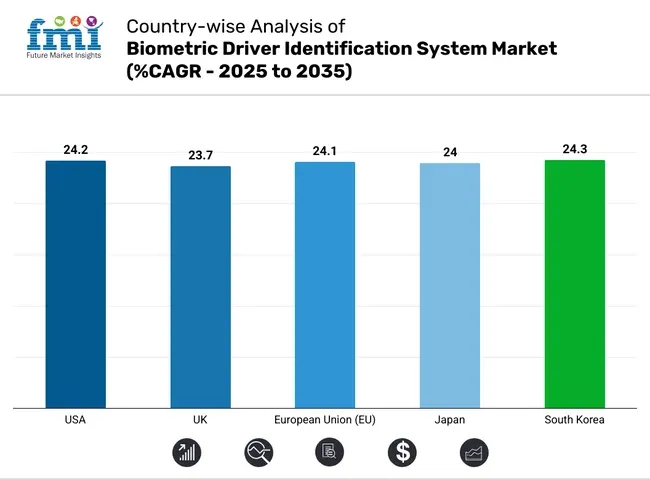
The USA market for biometric driver identification systems is quickly growing. This is because more advanced car security systems are being used. Also, more driver checks are being added to electric and fancy cars. Rules for safer roads are also pushing this trend. Groups like NHTSA and SAE International set rules for biometrics in cars and driver behavior tracking.
Some key trends are using face scans to start cars, tracking eye and head moves to spot driver tiredness, and using voice for a personal drive. Car makers with a focus on tech and strong demand for post-purchase add-ons are driving new ideas.
| Country | CAGR (2025 to 2035) |
|---|---|
| USA | 24.2% |
In the UK, the biometric driver identification system market is growing fast. Car makers are focused on driver safety, customization, and stopping theft. The DVSA and BSI ensure these systems meet safety and electronic rules. The market is boosted by facial recognition in electric car startups, more research in gesture-based ID systems, and the desire for cars that fit many drivers' needs. Car makers are working with biometric tech companies to roll out these new systems quickly.
| Country | CAGR (2025 to 2035) |
|---|---|
| UK | 23.7% |
The biometric driver identification system market in the EU is seeing rapid growth. This is due to EU safety rules and a bigger focus on advanced driver assistance systems (ADAS). The European Commission (EC) and UNECE rules help with the widespread use of biometrics in new cars.
Countries like Germany, France, and Italy are leading in this area. They have a high use of iris and face recognition systems. There is also more use of gait and posture checks, along with a growing focus on keeping car access secure. Luxury cars and electric vehicles are the main users of these systems.
| Region | CAGR (2025 to 2035) |
|---|---|
| European Union (EU) | 24.1% |
Japan's market for biometric driver identification systems is growing fast. This is because the country is a leader in self-driving car technology. They also have strong research in making biometric sensors smaller and adding them to shared transport platforms. Rules are managed by the Ministry of Land, Infrastructure, Transport, and Tourism (MLIT).
Important advances include voice and fingerprint recognition systems, tiredness detection in smart car cabins, and real-time health checks for older drivers. The market also benefits from partnerships between old car makers and large electronics companies.
| Country | CAGR (2025 to 2035) |
|---|---|
| Japan | 24.0% |
South Korea is becoming a key player in the biometric driver identification system market. This is due to new AI-based biometrics, advanced car tech, and government help for smart transport plans. The Korea Automobile Testing & Research Institute (KATRI) and MOLIT set rules for using biometrics in travel.
Key trends are joining many biometrics (like voice, face, and eyes) in smart cars, anti-theft systems based on body traits, and investments by car makers in driver ID-based personalization in electric and high-end cars.
| Country | CAGR (2025 to 2035) |
|---|---|
| South Korea | 24.3% |
The biometric driver identification system market is seeing a lot of growth. There is more need for smart car safety, personal settings, and following new rules. As cars get smarter, more biometric tech like face scans, fingerprint scans, and voice checks are used to stop others from using the car and make it easy for drivers.
These systems let drivers save their seat, music, and air settings, making driving better. Strict safety laws, mostly in North America and Europe, help speeds up this use. Many people want self-driving and electric cars, boosting the need for safe and easy ID systems for drivers. Car makers and tech firms are also putting money into making better biometric parts. This is leading to growth in high-end, mid-range, and work vehicle markets.
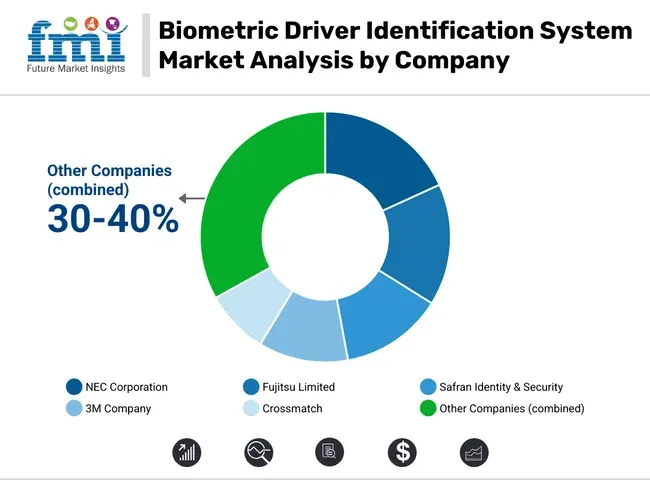
NEC Corporation (18-22%)
NEC leads the market with its cutting-edge facial recognition technology, offering high accuracy and speed, which is crucial for real-time driver authentication and vehicle security.
Fujitsu Limited (15-19%)
Fujitsu focuses on multimodal biometric solutions, integrating multiple recognition technologies to enhance reliability and user convenience in driver identification systems.
Safran Identity & Security (12-16%)
Safran specializes in high-security biometric solutions, with a strong emphasis on iris recognition technology, catering to premium automotive segments requiring stringent security measures.
3M Company (10-14%)
3M leverages its expertise in materials and electronics to develop innovative fingerprint recognition systems that are seamlessly integrated into vehicle controls for intuitive user experiences.
Crossmatch (6-10%)
Crossmatch emphasizes collaboration with automotive OEMs to deliver customized fingerprint-based authentication solutions, enhancing vehicle access control and personalization features.
Other Key Players (30-40% Combined)
Several other companies contribute to the Biometric Driver Identification System Market, including:
The overall market size for the biometric driver identification system market was USD 21,457 Million in 2025.
The biometric driver identification system market is expected to reach USD 184,410 Million in 2035.
Increasing emphasis on vehicle security, rising integration of biometric technologies in connected cars, demand for personalization and driver-specific settings, and regulatory support for advanced safety systems will drive market growth.
The USA, Germany, Japan, China, and the UK are key contributors.
The fingerprint recognition segment is expected to lead due to its ease of integration, high accuracy, and growing preference among automotive OEMs.






Full Research Suite comprises of:
Market outlook & trends analysis
Interviews & case studies
Strategic recommendations
Vendor profiles & capabilities analysis
5-year forecasts
8 regions and 60+ country-level data splits
Market segment data splits
12 months of continuous data updates
DELIVERED AS:
PDF EXCEL ONLINE
Biometric Vehicle Access Market Size and Share Forecast Outlook 2025 to 2035
Biometric Payment Cards Market Size and Share Forecast Outlook 2025 to 2035
Biometric PoS Terminals Market by Technology, End-Use, and Region - Growth, Trends, and Forecast through 2025 to 2035
Biometric Sensors Market Trends – Growth & Forecast 2025 to 2035
Biometric-as-a-Service Market Forecast 2025 to 2035
Biometric Lockers Market
Military Biometrics Market Size and Share Forecast Outlook 2025 to 2035
Behavioral Biometrics Market Size and Share Forecast Outlook 2025 to 2035
Healthcare Biometrics Market Trends - Growth, Demand & Forecast 2025 to 2035
AI-enabled Biometrics Market
Multi-Modal Biometric Cabin Sensors Market Analysis - Size, Share, and Forecast Outlook 2025 to 2035
Contactless Biometric Technology Market by Technology, Component, Application & Region Forecast till 2035
Fingerprint Biometrics Market by Authentication Type, Mobility, Industry & Region Forecast till 2035
Hand Geometry Biometrics Market Insights - Trends & Growth 2025 to 2035
Device-Embedded Biometric Authentication Market Size and Share Forecast Outlook 2025 to 2035
Driver and Staff Management Software Market Size and Share Forecast Outlook 2025 to 2035
Driver Monitoring System Market Growth - Trends & Forecast 2025 to 2035
LED Driver IC Market Analysis - Size, Share, and Forecast Outlook 2025 to 2035
LED Driver for Lighting Market Analysis – Growth & Forecast 2025 to 2035
LED Driver Market

Thank you!
You will receive an email from our Business Development Manager. Please be sure to check your SPAM/JUNK folder too.
Chat With
MaRIA